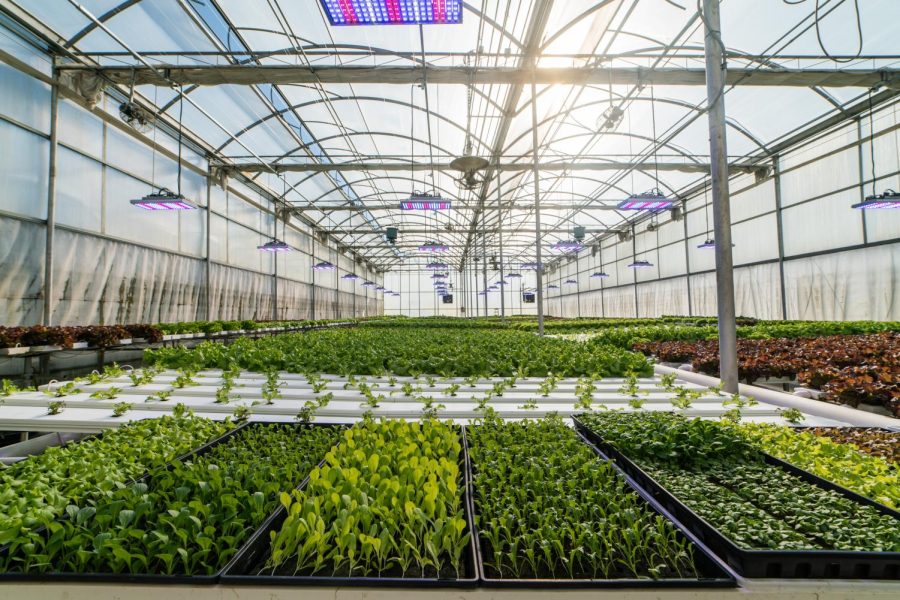Center for Food Innovation Proposes Year-Round Agriculture to Bolster Local Farming
Tyler’s Farm has grown leafy greens hydroponically since 2014.
The Center for Food Innovation, a nonprofit organization started at Oberlin College in 2020, wants Northeast Ohioans to eat more locally grown produce. CFI aims to have 25 percent of the produce consumed in Northeast Ohio be produced in the area by 2026. According to Jeff Heinen, CEO of Heinen’s Grocery Store, about 70 percent of the store’s produce is sourced locally during the summer months. However, large purchasers that require consistent food volume year-round find it difficult to source from local farms.
Lisa Roberson, National Director of Wellness and Sustainability for Morrison Healthcare, spoke at a webinar titled “Getting Local — Why Do Groceries, Hospitals, Restaurants and Others Want More Local Food?”
“[Seasonality] is a big barrier for us in purchasing [local] in many cases,” Roberson said. “If they had a year-round and consistent availability, [so] that you could actually meet distribution volumes that are the minimum requirements on a consistent basis … you could gain access to distribution in some markets that require larger volumes or more consistent volumes.”
To increase the availability of local produce year-round, CFI is a proponent of controlled-environment agriculture, which includes hydroponics, aeroponics, and vertical farming. According to a 2020 report by Oberlin Research Group titled “The Economic Potential of Vertical Agriculture in Northeast Ohio,” there are many viable properties for controlled-environment agriculture that have been zoned for agriculture or commercial use in our region, including abandoned malls and factories.
“Although deindustrialization had significant negative impacts on the economy in Lorain County, it is now presenting us with an opportunity to give new life to buildings and infrastructure that have been sitting empty for years,” the report reads.
Tyler Gogolek, owner of Tyler’s Farm, has been growing leafy greens in a 48-foot by 124-foot greenhouse since 2014. He received a $125,000 loan from the Farm Service Agency in 2014, but has found it difficult to secure funding for expansion since.
“Everything needs to be paid for upfront,” Gogolek said. “It’s not like growing in a field, where you till the field and go and just wait for nice weather. With controlled- environment agriculture, the biggest hurdle is the overhead.”
The high cost of creating a synthetic environment makes it difficult for entrepreneurs and farmers to afford hydroponic or vertical farming. Bara Watts, CEO of CFI, said that, in addition to government funding, private investment and grants are necessary for the success of the agriculture industry in Northeast Ohio.
CFI created the Your Amazing Food Idea pitch competition in partnership with Lorain County Community College’s Small Business Development Center to help entrepreneurs in the food industry receive funding and consultation. The competition has two tracks: the On the Road Track for businesses that have been established for two or more years and receive $250,000 or less in revenue a year, and the Startup Track for businesses that are in their infancy. Businesses that are accepted to the program will participate in pitch coaching before the actual pitch competition, in which they will compete for funding and consultation. Winners of the Startup Track will receive $2,000 in cash and $3,000 in services from SDBC and outside consultants. Winners of the On the Road Track will receive $10,000 in cash and $5,000 in services. Consultants from a variety of areas of expertise will be available for winners. Beth Gantz will provide consultation from her experience in the retail and food industry, while Tim Skaryd, president of Hospitality Sales and Management, will provide his expertise on food manufacturing.
Watts said that there is interest from investors in the agriculture technology industry, but that attracting those investors means working to de-risk an investment into Northeast Ohio.
“Investors are very, very cautious people,” Watts said. “You might think that they might be more into it because they go after things that are a little bit more new — cutting-edge stuff, but they are extremely cautious because they don’t like losing money.”
Investors and established companies considering moving their operations to Northeast Ohio must consider the cost of energy and the availability of purchasers in the area. CFI aims to attract large purchasers like hospitals and universities and encourage them to buy from controlled-environment companies.
“De-risking has to do with the cost of building and supplying,” Watts said. “It’s about having the talent that’s available. It’s about having some level of surety that they have customers that are gonna buy from them at the volume that they wanna produce.”
The knowledge required for controlled-environment agriculture includes traditional farming knowledge, but also integrated technology and biology. CFI has partnered with LCCC and The Ohio State University to begin building the educational pieces that will feed into the future workforce.
“A lot of farmers are losing their kids to technology and to other industries,” Watts said. “They’re leaving the farms. We would love more of these farmers to be hybrid, where they might have greenhouses or vertical farms on their land along with their crops that would give them year-round capabilities. We envision this being much more technology-driven, which is also a big skillset that we have in this region.”





